
The Illinois River is a principal tributary of the Mississippi River and is approximately 273 miles (439 km) long. Located in the U.S. state of Illinois, the river drains a large section of central Illinois, with a drainage basin of 28,756.6 square miles (74,479 km2). The drainage basin extends into Wisconsin, Indiana, and a very small area of southwestern Michigan.

The Sycamore Historic District is a meandering area encompassing 99 acres (400,000 m2) of the land in and around the downtown of the DeKalb County, Illinois, county seat, Sycamore. The area includes historic buildings and a number of historical and Victorian homes. Some significant structures are among those located within the Historic District including the DeKalb County Courthouse and the Sycamore Public Library. The district has been listed on the National Register of Historic Places since May 2, 1978.

11 South LaSalle Street Building or Eleven South LaSalle Street Building is a Chicago Landmark building that is listed on the National Register of Historic Places and that is located at 11 South LaSalle Street in the Loop community area of Chicago, Illinois, United States. This address is located on the southeast corner of LaSalle and Madison Street in Cook County, Illinois across the Madison Street from the One North LaSalle Building. The building sits on a site of a former Roanoke building that once served as a National Weather Service Weather Forecast official climate site and replaced Major Block 1 after the Great Chicago Fire. The current building has incorporated the frontage of other buildings east of the original site of Major Block 1.

The Galena Historic District is a historic district located in the city of Galena, Illinois, USA. The historic district encompasses 85 percent of the city of Galena and includes more than 800 properties. The downtown area consists of three successive tiers made up of Main, Bench and Prospect Streets. Within the boundaries of the district are such notable homes as the Ulysses S. Grant Home and the Elihu B. Washburne House. The Galena Historic District was added to the U.S. National Register of Historic Places in 1969.

There are 68 properties listed on the National Register of Historic Places in Albany, New York, United States. Six are additionally designated as National Historic Landmarks (NHLs), the most of any city in the state after New York City. Another 14 are historic districts, for which 20 of the listings are also contributing properties. Two properties, both buildings, that had been listed in the past but have since been demolished have been delisted; one building that is also no longer extant remains listed.

Davenport Bank and Trust Company was for much of the 20th century the leading bank of the Quad Cities metropolitan area and the surrounding region of eastern Iowa and western Illinois. It was at one time Iowa's largest commercial bank, and the headquarters building has dominated the city's skyline since it was constructed in 1927 at the corner of Third and Main Streets in downtown Davenport, Iowa. It was acquired by Norwest Bank of Minneapolis in 1993 and now operates as part of Wells Fargo following a 1998 merger of the two financial institutions. The historic building was listed on the National Register of Historic Places in 1983 under the name of its predecessor financial institution American Commercial and Savings Bank. In 2016 the National Register approved a boundary increase with the Davenport Bank and Trust name. It was included as a contributing property in the Davenport Downtown Commercial Historic District in 2020. It remains the tallest building in the Quad Cities, and is today known as Davenport Bank Apartments as it has been redeveloped into a mixed-use facility housing commercial, office and residential space.

The Renwick Building is located in downtown Davenport, Iowa, United States. It has been listed on the National Register of Historic Places since 1983, and on the Davenport Register of Historic Properties since 2000. In 2020 it was included as a contributing property in the Davenport Downtown Commercial Historic District. It is known locally for the large painted sign on the north side of the building depicting the Bix 7 Road Race.

The Centralia Commercial Historic District is a historic commercial district comprising several blocks of Broadway in downtown Centralia, Illinois. The district includes 57 contributing buildings as well as a historic water tower and sign. Centralia's business district developed around the Illinois Central Railroad tracks, as the town was established by and named for the railroad. The earliest buildings in the district date from the 1850s, as the city was platted in 1853. Centralia's first commercial buildings were mainly designed in the Italianate style, which was predominant until the end of the 19th century; the Romanesque Revival style also gained popularity in the 1880s. Around the turn of the century, the Commercial style became the most popular style in the district. The Renaissance Revival and Classical Revival styles can also be seen in buildings from this era, and by the 1930s Art Deco and Modernist architecture became popular.

The Macomb Courthouse Square Historic District is a historic district located in downtown Macomb, Illinois. The district covers six full and four partial city blocks and includes 65 contributing buildings. The McDonough County Courthouse, an 1871 Second Empire building, is the centerpiece of the district. The courthouse is situated in the middle of a Harrisonburg-style courthouse square, which is flanked by two north-south streets and intersected by a single east-west street that splits around the courthouse; the layout is unusual in Illinois, though Stark County has a similar layout. The surrounding buildings are mainly commercial, though several are government buildings. Brick commercial blocks, often with Italianate or Queen Anne details, dominate the district's architectural landscape; the district's more modern buildings, which date to the first half of the twentieth century, mostly have Art Deco or Moderne styling.
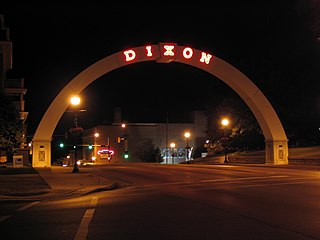
The Dixon Downtown Historic District is a historic district which encompasses 154 properties in downtown Dixon, Illinois. The district includes the city's commercial core, which includes buildings dating back to the 1850s. Dixon's commercial buildings are largely two-story brick structures and reflect the popular architectural styles of their era of construction; the Italianate style is most common in 19th-century buildings, while the Commercial style and revival styles such as Neoclassical and Beaux-Arts became popular after 1900. Many of Dixon's prominent government and community buildings also lie within the district, including the Lee County Courthouse, City Hall, its current and former post offices, and several churches. A residential section on the west side of the district includes Queen Anne and Craftsman style homes; the former style was popular in the late 19th century, while the latter was popular in the early 20th.

The Ottawa Commercial Historic District is a historic district in downtown Ottawa, Illinois. The district includes 195 buildings and structures, most of them commercial buildings, spread out over 26 city blocks. The oldest buildings in the district, located near the Illinois and Fox rivers, were built in the 1830s. The district expanded northward toward the Illinois & Michigan Canal over time, and the buildings in its northern half date to the mid-to-late 19th and early 20th centuries. The district's buildings include most popular Midwestern architectural styles from the mid-19th century through the mid-20th century; some of the most common are vernacular frame buildings from the early years of the district's growth, Italianate buildings from the mid-19th century, Commercial style buildings from the early 20th century, and International Style buildings from the mid-20th century.

The Elgin Downtown Commercial District is a historic district encompassing the commercial core of downtown Elgin, Illinois. The district includes 94 buildings, 76 of which are considered contributing buildings to its historic character. While development in downtown Elgin began in the 1830s, the oldest buildings in the district were built in the 1870s; most of the district's buildings were built in the late 19th and early 20th centuries, but its development continued through the 20th century. The majority of the buildings in the district are two- and three-story commercial buildings, but it also includes several taller commercial buildings, churches, a public library, and a power station. Most of the 19th-century buildings in the district have Italianate or Queen Anne designs, while the 20th-century buildings features styles such as Colonial Revival and Renaissance Revival.
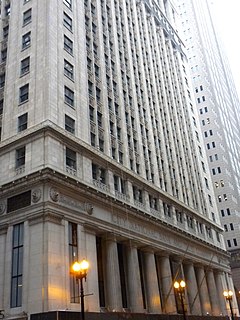
The Continental and Commercial National Bank is a historic office building located at 208 S. LaSalle Street in Chicago's Loop. The 21-story building was built in 1911-14 for the Continental and Commercial National Bank, at the time one of the largest banks in the nation. Architect Daniel Burnham designed the building in the Classical Revival style; Burnham, who was perhaps best known for his 1909 plan of Chicago, was a proponent of the style and used it in office buildings in multiple cities. The building's main entrance features a three-story colonnade with eight Doric columns; the eighteenth through the twentieth floors feature a matching colonnade, which forms the building's capital. A frieze and belt course separate the fourth and seventeenth floors from the shaft of the building, giving the building a small amount of horizontal emphasis. An open court occupies the center of the building, allowing natural light to reach its interior offices.

The Jacksonville Downtown Historic District is a national historic district in downtown Jacksonville, Illinois. The district encompasses a commercial area surrounding Central Park, the city's public square. Development in the district began in 1825, when Jacksonville was platted and the public square was created; the first buildings on the square were built the same year. Most of the buildings in the district were built between the 1840s and 1940s, and a large number were built during a late nineteenth century building boom. Seven of the buildings were once cigar stores, a reflection of Jacksonville's large cigar making industry. The district includes examples of many of the popular architectural styles of the nineteenth and twentieth centuries; Italianate and Victorian buildings are especially common.
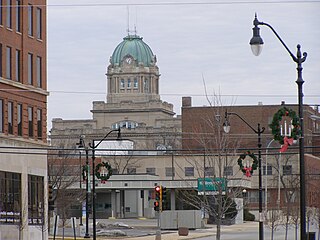
The Kankakee Downtown Historic District is a national historic district in downtown Kankakee, Illinois. The district includes 73 buildings which form the commercial and governmental center of the city, most of which are grouped along Court Street and Schuyler Avenue. While development in the district began in the 1850s, the oldest surviving building in the district is from 1864; the newest contributing buildings are from the mid-twentieth century. Kankakee's Courthouse Square and the 1908 Kankakee County Courthouse are part of the district; other government buildings in the district include Kankakee's post office, police and fire station, and armory. Most of the district's other buildings are one- to three-story brick or stone commercial buildings. Many popular architectural styles of the nineteenth and twentieth centuries are represented in the district; the Italianate, Neoclassical, and Art Deco styles are among the most common.
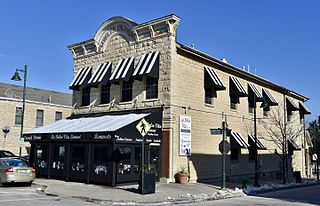
The Lemont Downtown Historic District is a commercial historic district encompassing 14 city blocks in downtown Lemont, Illinois. The district has served as the village's downtown since the 1850s, when the newly opened Illinois & Michigan Canal and subsequent limestone quarrying in the area sparked a local economic boom. It expanded through the late nineteenth and early twentieth centuries as new railroads and the Chicago Sanitary and Ship Canal brought residents and business opportunities to the village. The commercial buildings in the district exhibit a variety of common building types seen between 1850 and 1950; one-part, two-part, gable-front, and false-front buildings are all present, and their designs feature Italianate, Commercial, and revival style architecture. The district also includes several of Lemont's government buildings, including its village hall and post office.

The Downtown Peoria Historic District is a commercial historic district encompassing seventeen city blocks in downtown Peoria, Illinois. The district's buildings reflect Peoria's development as an industrial center and major Illinois city. While Peoria was platted in the 1820s, the oldest buildings in the district date from 1867, shortly before Peoria's economic boom of the 1870s. In the late nineteenth century, Peoria's whiskey industry was among the largest in the world, and many downtown civic improvements and public buildings were funded by whiskey profits. By the turn of the twentieth century, another economic boom brought a large retail district to downtown Peoria; many of the department stores from this period still stand in the district. An urban renewal project in the mid-twentieth century brought several Modernist skyscrapers to downtown Peoria as well, including the Caterpillar administration building, the DeKroff Metz and Company Building, and the First Federal Savings Tower.
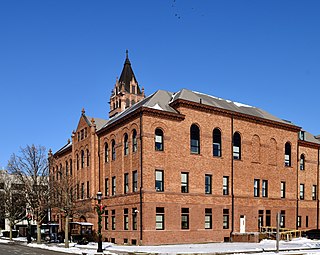
The Downtown Urbana Historic District is a commercial historic district encompassing seven city blocks in downtown Urbana, Illinois. The buildings in the district reflects downtown Urbana's development as the county seat of Champaign County and a regional commercial center. While Urbana was founded in the 1830s and began its development in the ensuing decades, the oldest buildings in the district are from the 1870s. The city expanded considerably in the late nineteenth and early to mid twentieth centuries, and most of the district's buildings were constructed during this period. Local architect Joseph Royer designed many of the district's most prominent buildings, including the 1901 Romanesque Revival Champaign County Courthouse.

The Champaign Downtown Commercial District is a commercial historic district encompassing 19.4 acres (7.9 ha) in downtown Champaign, Illinois. The district includes some of the oldest parts of the city's downtown, and its buildings represent the city's development in the late nineteenth and early twentieth centuries. Champaign was founded in the 1850s when the Illinois Central Railroad added a station in a rural area west of neighboring Urbana and the town formed around it; the oldest buildings in the district date from the following decade. Several buildings connected to the Illinois Central are included in the district. The opening of the University of Illinois at Urbana–Champaign in 1867 furthered Champaign's growth, and development in the downtown commercial district continued steadily through 1940. The district's commercial buildings exhibit a variety of building types and architectural styles, including Italianate, Art Deco, and various revival styles. Champaign's City Building and other local government buildings are also part of the district.

The Downtown Rock Island Historic District is a national historic district encompassing 82.3 acres (33.3 ha) in downtown Rock Island, Illinois. The oldest buildings in the district are from the 1860s, two decades after Rock Island's founding, and buildings from then until 1969 can be found in the district, making it reflective of the city's development over time. The majority of the buildings in the district are commercial buildings, as downtown Rock Island has historically been the city's commercial center; these include several building types, mainly one-part and two-part commercial blocks, designed in a wide variety of the architectural styles popular in the late nineteenth and early to mid twentieth centuries. The district was also historically the center of Rock Island's social life, and many theaters and clubhouses for social organizations can be found in the district. Several of Rock Island's major government buildings, including the city hall and old county courthouse, are also part of the district.






















